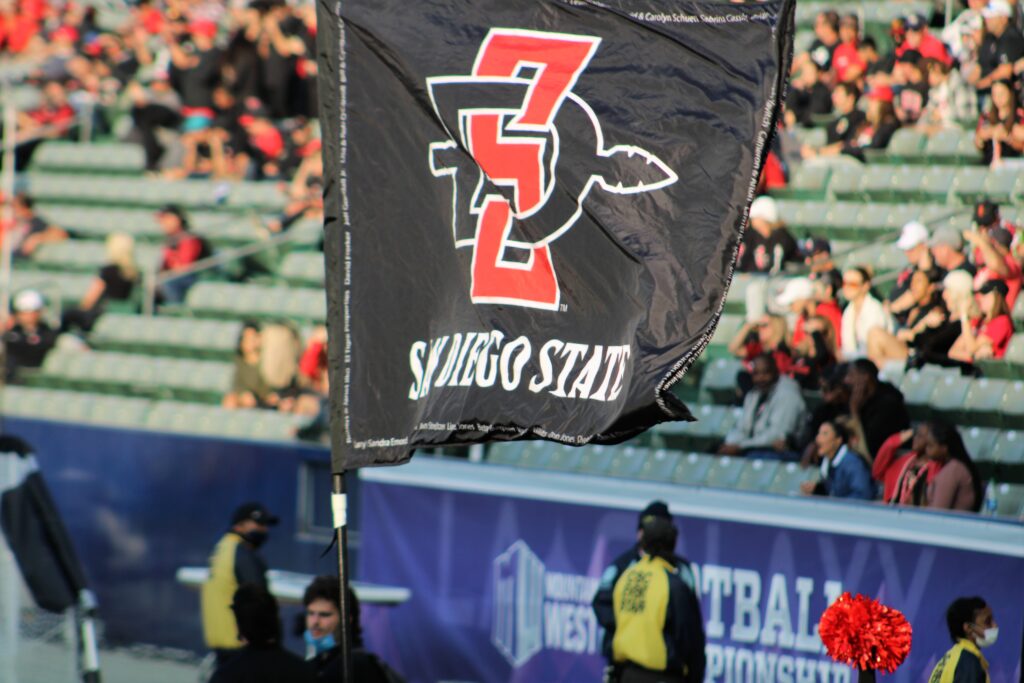SDSU opens spring camp in 3 weeks

Credit: Paul Garrison/EVT

Three weeks from today (Monday, February 7), San Diego State opens spring camp for the 100th season of Aztec football.
The practices come at the end of a five-week Winter Conditioning and serve as a reward for the grueling workout regimen SDSU’s coach Adam Hall puts his players through. In the sixth episode of The SDSU Football Podcast, Hall described what the team will go through between now and August.
What can the Aztecs legitimately accomplish in the 15 practices that start on February 28? Even if this team could gel over that time and be better than the 2021 team was at any point last year, there is no guarantee that success would translate to September 3 against Arizona. Below are three storylines to mark the three-week anniversary of the start of spring camp. Each is intended to be specific to what the coaching staff can actually get done during the brief time they have their team on the field.
Can the QB(s) be a threat apart from play-action?
As long as the Aztecs do not have an established signal-caller, the quarterback position will be story number one. Offensive coordinator Jeff Hecklinski has gone on record to say the QBs in his system need to be “the most dangerous player on the field.” That moniker fit Jordon Brookshire and Lucas Johnson for only four of the fourteen games last season. Johnson played to that standard in two starts, against UNLV and UTSA. Brookshire reached that level in a pair of games against Arizona and Boise State.
A closer look at their success reveals a clear pattern. The duo did most of their damage working off play-action. The move to spread following the 2018 season was due in large part to their inability to use the play-action effectively. The 2021 team, for all of its passing deficiencies, was the first group in nearly a decade to frequently take advantage of the opposition stacking the box to stop the run.
If the Aztecs consistently use play-action all season in 2022 as they did in the four games mentioned above, their passing game will have its most prolific year since Ryan Lindley graced the Mesa. However, if the offense is going to reach Hecklinski’s aspirations of a balanced attack averaging 40 plus points a contest, the QBs must be dangerous in straight drops without the aid of defenses keying on the running back.
At the division one level, 7-on-7 skelly drills should only be a challenge for the defense. Without a pass rush, signal callers at State should carve up their teammates on the other side of the ball with relative ease. Establishing themselves in those drills would go a long way towards the QBs growing into threats in all phases of the passing game.
Will a dependable two-deep develop on the offensive line?
EVT SDSU football beat writer Andre Haghverdian asked head coach Brady Hoke in last week’s press conference if he was “concerned” about the youth on the offensive front. Hoke’s response sounded like he was trying to instill belief in his players more than anything else. After all, if he was excited and not worried to see his youngsters play, there would have been no reason to bring in transfer Cade Bennett.
Brady Hoke on whether he is concerned about the lack of experience on the offensive line heading into 2022 season. Only two linemen on the roster have played more than 36 career snaps at the FBS level. pic.twitter.com/P2U34aiPpW
— Andre Haghverdian (@ahaghver23) February 1, 2022
Spring camp is the perfect opportunity to develop a two-deep for the true offensive line competition in the fall. The names and pedigrees are known. Bennett chose the Aztecs over Penn State and most of the Pac-12. Ross Ulugala-Maseuli plays in San Diego instead of at Alabama, Michigan, or USC. Joey Wright also rejected USC along with Arizona and Arizona State to make his home on the Mesa. USC was likewise a bridesmaid with Georgia and Oklahoma, among others, for Josh Simmons’ services.
On paper, the offensive line, which has consistently graduated players into the NFL over the past decade, is more skilled than it ever has been. That tantalizing talent and potential must be realized by at least two Aztecs at every position before the end of the 15 practice audition, or else Hoke’s anticipation will turn to concern.
Will SDSU solidify the secondary?
Building off a second of Haghverdian’s questions, the back end of the Aztecs’ defense should be in better shape heading into spring camp than in years past. Patrick McMorris is established at the Aztec position. Entering his second season as a starter, expectations should be off the charts for the talented safety. He begins 2022 among the favorites to win MW Defensive Player of the Year and should be on every preseason award watch list. If McMorris’ game takes an additional leap in production, not only will he rise on NFL draft boards, but defensive coordinator Kurt Mattix could turn him into the sun the entire defense orbits around.
Brady Hoke on whether the secondary is a lot more stable heading into Spring Camp this year compared to last year. pic.twitter.com/LFswfCjJPi
— Andre Haghverdian (@ahaghver23) February 1, 2022
McMorris’ promise aside, there is some work to do to match the level of the 2021 group that had three players on the all-conference team. Ever since Damontae Kazee stepped into the starting lineup, the Aztecs have had a star at one corner. Kazee passed the baton to Kameron Kelly, who passed it to Luq Barcoo and Darren Hall. Last season, Tayler Hawkins assumed that mantel. The hole Hawkins’ departure leaves is substantial as his starring role in the Hula Bowl shows.
While there are experienced players who are obvious replacements, Hoke including younger corners in his press conference was not without reason. Dallas Branch, Noah Tumblin, and Noah Avinger have each had great moments, but they have a long way to go to become stars.
As challenging as it might be to replace Hawkins, replacing Trenton Thompson might prove even more difficult. One of the weaknesses of the 3-3-5 is covering wide receivers in the slot. Most teams use a third corner to fill that role, but SDSU uses a third safety. For all of the terrific defensive backs during the last decade-plus, one issue for the Aztecs was safeties getting beat deep, especially in man coverage. It was not until Tariq Thompson manned the position that SDSU could consistently cover a third wideout in the slot.
Last year, SDSU’s first without Tariq Thompson, opposing offenses targeted that problem area in the 3-3-5. Trenton Thompson responded. He was tied for fourth in the NCAA with 14 pass breakups. Of the eight players nationally with at least 14 PBUs, Thompson was one of two with at least three interceptions. Who replaces him as the nickel defensive back?
[wpedon id=”49075″ align=”center”]
Heading into last season, converted corner Cedarious Barfield looked like a perfect candidate, but he did win that position. Barfield would cover the fourth receiver if the opposition split four out wide. When Barfield was replaced by CJ Baskerville late in the year following an injury, McMorris slid over to cover the fourth wide receiver.
Numerous exciting players throughout the roster could work their way into the battle for playing time. Mattix will be looking for the best five defensive backs. If that means playing three corners in obvious passing downs, he would.
The answers to these questions will start to shake out in 21 days, but who is counting?
My earliest sport’s memory involve tailgating at the Murph, running down the circular exit ramps, and seeing the Padres, Chargers and Aztecs play. As a second generation Aztec, I am passionate about all things SDSU. Other interests include raising my four children, being a great husband and teaching high school.